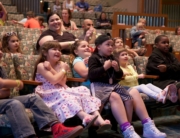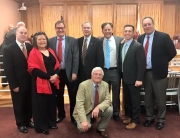
Nathan Graeser is CIR’s community program administrator overseeing the Los Angeles Veterans Collaborative and a chaplain in the California Army National Guard.
by Nathan Graeser
In January, the VA settled the most dramatic lawsuit in its 128-year history. The 388-acre West Los Angeles VA campus originally dedicated to veterans as a “spiritual home” had lost its way and the suit, among other forces, called for a redesign of its master plan to reconnect to its mission. Officials have reached out to the veteran community to ask them what they need and want from the new campus.
As local experts in the veteran community, the USC Center for Innovation and Research on Veterans & Military Families had constantly been asked what the most pressing needs were facing veterans. Until recently, we didn’t have a way to answer that question. For the past year, though, the Los Angeles Veterans Collaborative has been using the results from CIR’s first comprehensive study of the local veteran population to pinpoint areas of need. Moving forward, the VA campus should also focus on the areas outlined in the study, as well as the lived experience of thousands of veterans and service providers on the ground.
Let’s focus on transition and relocation support.
Currently, we estimate about 12,000 new veterans arriving in Los Angeles each year, or about 1,000 a month. New veterans face tight rental and housing markets, diminished civilian networks and a daunting cultural shift from military to civilian life after service. Our study showed that more than half of them do not know where to find the help they needed. Veterans need to know that there’s a place to go to when they get out. Although the VA cannot be the city’s only solution, it can play an important part in linking newly transitioned veterans into happy well-adjusted lives after service.
Let’s focus on vulnerable populations.
Veterans are not all white, middle-class men. As our wars come to an end, most of the services and resources provided for veterans have failed to account for the change in demographics of those returning over the past 14 years. While minority veterans have always faced difficulties returning home from service, the military now actively deploys females and LGBT veterans who face unique challenges. Our study found that almost 60 percent of female veterans experienced sexual assault, of which less than 10 percent received help. We know these populations are less likely to self-identify as veterans, making it more difficult to reach out for help. The campus needs a safe place that allows these veterans to receive care and treatment they deserve.
Let’s focus on a holistic, wellness-centered approach.
The veterans in our study identified a wide range of services needed during transition. We must provide a comprehensive and holistic approach to support them as they reintegrate into civilian life. This means designing a continuum of care that provides an individualized program with housing assistance, employment support, counseling, legal services, etc. But, more importantly, the VA campus should be focused on living and living well, not just on sickness. The campus should support activities that build on the strengths of veterans and their families, fostering long-term wellness (e.g., childcare, marriage counseling and family retreats), parenting (e.g., birthing classes, midwifery and parenting classes and family support groups), health (e.g., recreational activities, gym facilities, nutrition, homeopathy) and quality of life (e.g., spirituality, arts, gardening, woodworking).
This is hardly an exhaustive list. Nor are these recommendations designed to be prescriptions for the VA to provide the litany of services that a veteran will need over the course of their lifetime. But it is a starting point based on what we asked local veterans.
A funny thing happens when you ask veterans what they want. Most just look puzzled at first. In fact, most look surprised to be asked. When they finally do answer, it’s usually “I don’t know” or “Let me think about it.” But, then something surprising happens. They come back; they ask questions; they comment. For veterans who are used to taking orders, sharing how they want to be treated is a foreign concept. Yet, that’s the opportunity today. For the first time in history, the VA has asked its privates, sergeants, gunnies, and officers, and they have responded. Los Angeles veterans—across services, records and eras—have sought to shape the future of these 388 acres. This Veterans Day, if you’ve served in the military and live in greater Los Angeles, take a moment and answer this question: What do you want?







